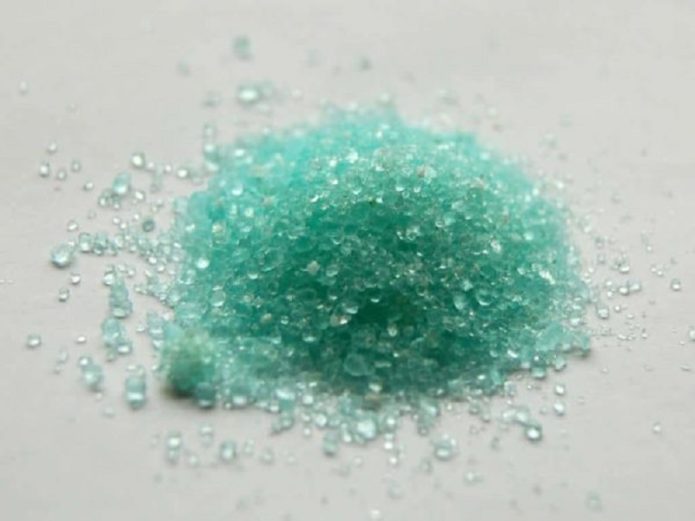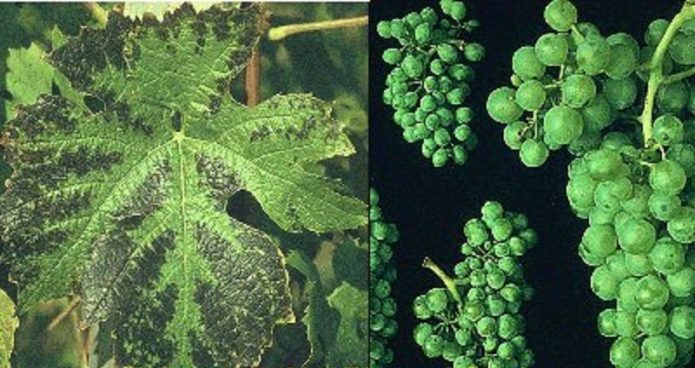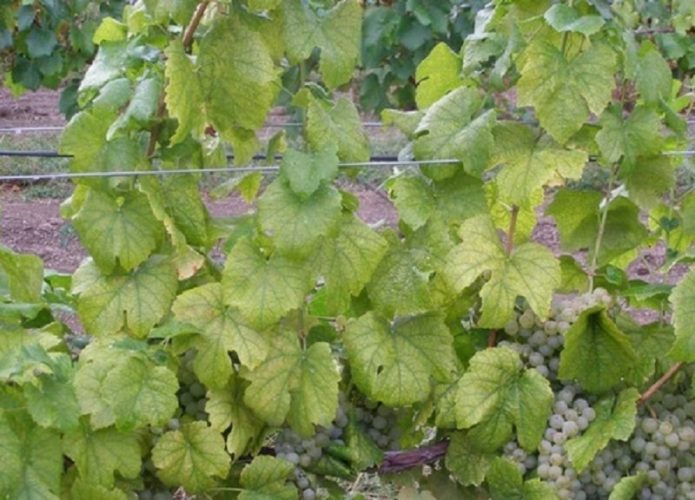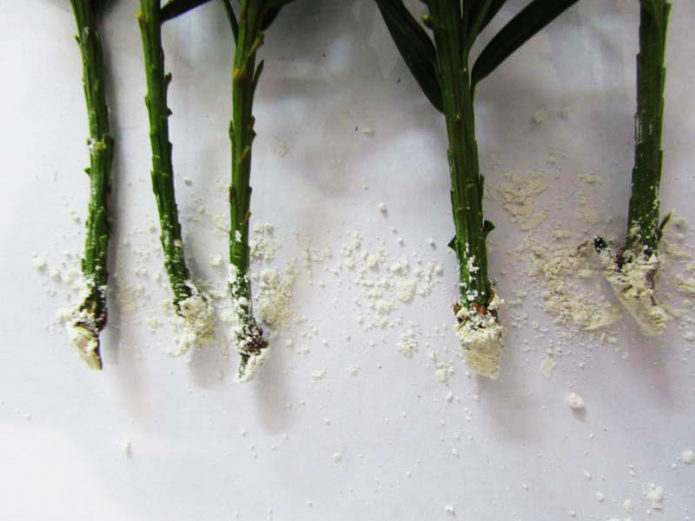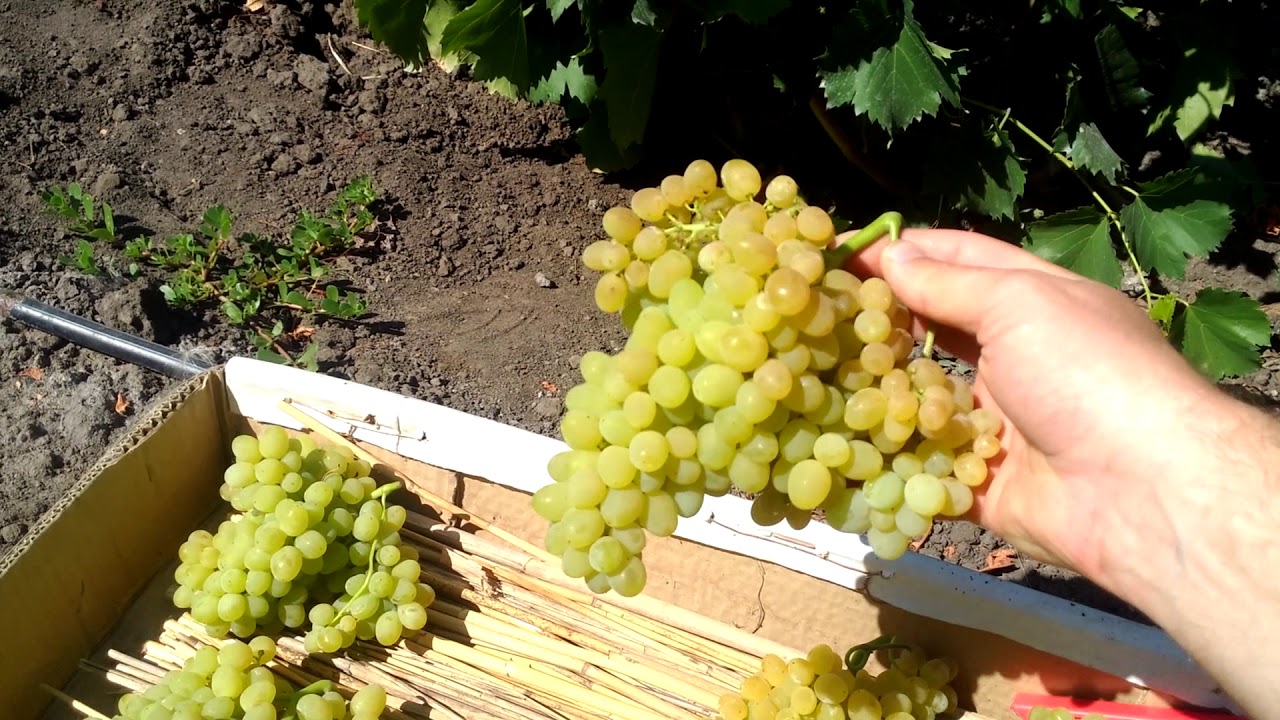In order for the grapes to grow healthy, you will have to dance with the sprayer around them quite often. Knowledge in the field of chemical and biological "weapons" against diseases and pests, coupled with meticulous treatments will help preserve the grapes.
Content
Complex preparations in a simple form
The invention of protective agents for grapes and the adaptation of insidious diseases to them is a dialectic process, continuous and improving. The modern market is able to offer various preparations that will keep the plant in good shape from early spring to the first frost.
Bordeaux mixture
Contact fungicide intended for the prevention and treatment of anthracnose, mildew, oidium, cercosporosis, alternaria (black rot), melanosis, rubella, mosses and lichens of grapes. In addition, the drug is a source of calcium. Bordeaux mixture is available in plastic packages of 100 and 200 g, the contents of which include separately packaged quicklime and copper sulfate (it can be poured into the main package). Lime is a white gritty powder, copper sulfate is small bright blue crystals.
Copper ions, when they come into contact with cell molecules, enter into a reaction, which is why the "insides" of the cell - its protoplasm, as it were, is sintered (coagulated), respiration processes are suppressed, nonspecific denaturation of proteins occurs - they "melt", losing the ability to absorb water, electrolytes and nutrients ... The mixture takes effect 2–4 hours after application. Processing is carried out at a temperature of +15 ° C at night. Waiting period (time from last processing to harvest) 1 month.
For self-cooking, use plastic or glass containers, but not iron. The most popular solutions are 1% and 3% concentration, therefore, for the first option, 130 g of lime (it always takes a little more) and 100 g of copper sulfate, and for the second - 450 g of lime and 300 sulfate.
Preparation of Bordeaux mixture:
- In a 10-liter bucket, lime is diluted with five liters of water, that is, they are quenched. Water is added gradually.
- In another container, copper sulfate is dissolved in a small amount of hot water. The volume is gradually brought to 5 liters.
- A solution of copper sulfate is poured into the milk of lime, and that's the only way (!). The finished mixture has a deep blue color.
Test control is carried out using litmus paper: if the concentration is correct, the paper will not change color, if it is wrong, it will turn pink. People's control with an iron nail: a degreased, non-rusty nail is immersed in the mixture for a few minutes, then allowed to dry. From the "correct" mixture, the usual limescale will remain, and from the highly concentrated iron, it will be covered with a reddish coating of copper.In this case, Bordeaux is topped up with milk of lime until the reaction becomes neutral. The concentrated solution has a strong alkaline reaction and is capable of burning grape leaves. The risk of leaf burns also exists in industrial areas where acidic pollution of the atmosphere is possible.
Before pouring into the sprayer, the solution is filtered so that the nozzle does not clog. Since the lime particles are heavy and gradually settle, the solution is periodically stirred during operation. The working mixture is used immediately or, in extreme cases, it is stored for 1 day by adding 5-10 g of sugar per 10 liters of the mixture.
The grapes are sprayed in several stages:
- Before budding in March, use a 3% solution.
- Before flowering, concentration 1%.
- After flowering, also 1%.
- At the end of October, before frost, with a solution of 3% concentration.
In a rainy spring, grapes are additionally processed after the growth of 4-5 leaves, in dry weather - 10 leaves.
Bordeaux mixture is not miscible with other drugs. Analogues: Abiga-Peak, Kuproksat, Polykhom, Oksikhom.
Fungicide belongs to the 2nd class of danger for humans, 3 - for bees, therefore, they are isolated for the duration of treatment and for the next 5 hours.
Copper sulfate
The substance is also used alone as a prophylactic contact fungicide. The product is popular due to its low price, availability, convenient packing of 50, 100, 300, 500 g.
Principle of operation: the resulting film covers the surface of the vine, preventing the development of mold and mildew, and protects from low temperatures. Spring treatments are carried out before bud break in the morning. For young bushes from 1 to 3 years old, use a solution of 0.5% concentration, for older ones - 3-5%. Since the results of labor can be washed away in the spring in the rain, autumn spraying is considered more effective, because the plant is covered for the winter and nothing will interfere with the effect of the drug. Copper is responsible for the proper development of the plant - its lack leads to chlorosis (decreased photosynthetic activity), and excess can kill.
Copper sulfate cannot be used in parallel with other substances, but it is combined only with preparations based on colloidal sulfur.
Precautions: use glasses, gloves, respirator. In contact with mucous, sweaty skin of the hands, it can cause poisoning, a dose of 30-50 ml is lethal to life.
inkstone
Fungicide with a broad spectrum of action - antiseptic, fertilizer, prophylactic agent against mildew, oidium, spotted necrosis, bacterial cancer, anthracnose, grape cushion, etc.
Iron vitriol (ferrous sulfate) is a powder of transparent crystals of turquoise color in small packages of 100, 150, 200 and 300 g. With complete safety for humans, if it comes into contact with the skin, it is enough to rinse with water, you should not neglect the means of protection.
Preventive spraying:
- In the spring, with the onset of the first warm days, but before the awakening of the kidneys, the concentration is 0.5% (50 g per 10 liters of water). It is impossible to handle the leaves in order to avoid burns. The resulting film on the surface of the vine will delay the development of the buds for 2 weeks, and they will be able to survive recurrent frosts.
- In autumn, in the second half of October, early November, the vine and the land around the bush are cultivated in order to destroy the wintering pests. For plants 1–3 years old, use a solution of 3% strength (300 g per 10 l of water), for older bushes - 5% solution (500 g per 10 l of water). The forming film tightens the bark, preventing the fungus from "catching". It also destroys lichens and mosses.
- Autumn processing is combined with covering the grapes for the winter. This treatment helps to identify oidium: the bark darkens and the foci of infection become black.
Processing cuttings
Before laying the cuttings for storage, they are dipped for 2-3 seconds in a 5% solution of ferrous sulfate. It promotes the formation of callus (induration, keratinization) on the lower cut and active root growth.Before planting, the cuttings are sprayed with a 0.5-1% solution, the development of the kidneys is delayed for 2 weeks, reducing the risk of freezing, and the survival rate increases.
Treatment
Iron starvation is accompanied by a decrease in the growth of young shoots, the leaves turn yellow, and the bunch is not formed. Watering the feeding area of the bush with a solution of 100 g of ferrous sulfate + 20 g of ascorbic acid in 10 liters of water is carried out. Use 100-400 g (10-40 liters of solution) under the bush, depending on its age and the severity of the disease.
Compatibility: Do not mix with hydrated lime.
Fitosporin-M
Systemic biofungicide of a therapeutic and prophylactic orientation, created on the basis of living cells and spores of hay bacillus bacteria. Spraying is carried out in cloudy weather or in the evening, because bacterial spores die from the sun. Available in paste, powder and emulsion form. Preventive treatment of healthy grapes is effective against mildew and oidium; the drug is almost useless for treating diseased bushes. Fitosporin-M is non-toxic and does not have a waiting period, that is, you can pick bunches on the day of processing. Dissolving 1 tbsp. l. paste in 10 liters of water, the grapes are sprayed in the phase of budding, loosening of inflorescences and after flowering. To maintain an overall healthy background of plants, fungicide treatments are recommended every 2 weeks.
The drug is not combined with mineral fertilizers in order to avoid an excess of one of the minerals, and the series enriched with GUMI bioactive fertilizer is not used for spraying. But it is combined with most fungicides, growth stimulants, insecticides, except for those that have an alkaline reaction. Compatibility: with fungicides Strobi, Quadris, Tilt premium, Fundazol, Vitivax 200, insecticides - Decis, Aktara, Fitoverm, growth stimulants - Zircon, Ribav-Extra, Epin, Oberig, Plantafol. antibiotic drugs - Fitolavin.
Analogues: Alarin and Gamair, Phytodoctor.
Shavit
Patented Israeli contact-systemic fungicide for the treatment and prevention of powdery mildew, mildew, black spot, infectious drying. In the case of gray and white rot, only preventive treatments before and after flowering are effective. If rot manifests itself at the stage of cluster formation, use Flint-Star. Principle of action: blocking the development, spread of fungal cells by destroying their membranes. Shavit acts immediately after application and for 14 days. The first treatment before flowering is preventive, followed by lesions (20 g per 10 l of water). Against powdery mildew, take 30 g of the substance. Shavit is moderately dangerous for humans and fauna. Analogs: Stroby, Delan, Basf.
Strobe
Fungicide of therapeutic and prophylactic action is distinguished by resistance to precipitation, efficiency at low temperatures, safety for bees. For a person, traditional protective measures are sufficient. For a working solution in 10 liters of water, 5 g of granules are diluted, all parts of the grapes and the ground under it are sprayed. When pruning Strobi grapes, it is possible to process the cutting tool and cut points. Use the mixture within 2 hours. Strobi treatments are especially effective before and during flowering and fruiting. The drug does not accumulate in the plant, the waiting period is 30 days.
Kurzat R
Contact systemic fungicide for the prevention and treatment of mildew, soluble powder, hazard class 3. The main working substance - copper oxychloride, protects the surface of the plant, and cymoxanil acts from the inside. The action of Kurzat R begins in 1-2 days, the result lasts 28-30 days. Prophylactic spraying (30 g per 10 l of water) with a frequency of 10-12 days has a good effect, the total number of treatments is 3-4 per season. It is better to start treatment at the first signs of damage. The working solution is prepared and consumed in one day. Analog: Ordan.
Kurzat M
Fungicide (analogue of Kurzat R) based on mancoceb, enriched with manganese and zinc, therefore it is also used as a microfertilizer. Zinc increases the resistance of grapes to drought, cold, and manganese prevents chlorosis.The interval between treatments in this case is more - 10-14 days. The waiting period is 1 month. Analog: Desfilar.
Bottom
An extremely poisonous preparation that requires the utmost care and attention when preparing a working solution. For work, you will need personal protective equipment - a dustproof suit, boots, a gas mask. The fungicide is intended for the treatment of large areas. Dnok's supporters use it at their own peril and risk, but only in a desperate situation and no more than once every 3 years.
Opponents of radical measures recommend replacing Dnok with iron and copper sulfate, the fungicide Double Strike.
Tilt
A systemic fungicide from the category not recommended for use in a private household, given its toxicity and the need for professional protective equipment for humans. But still. Tilt is used once a season in case of illness. The waiting period is 40 days. Restrictions on use: dry windy weather at temperatures above +30 ° C. Tilt must not be poured down the drain. It is interesting that the applied drug works better in the heat than most others, the plants literally come to life before our eyes. The solution is prepared immediately before work: 2-3 ml per 10 l of water.
Horus
Systemic fungicide of therapeutic and prophylactic action successfully fights against powdery mildew, mildew, gray and fruit rot, leaf spot. The active substance cyprodinil penetrates into the leaves within 2-3 hours and, thanks to the sap flow, is spread throughout all parts of the plant. Since the cuticle (cuticle) of old leaves is "impenetrable" for the preparation, treatments are carried out in the spring on young foliage. The healing effect is already noticeable at + 3 ° C, but decreases above +25 ° C. The drug is not phytotoxic. The solution is prepared in a proportion of 6 g per 10 liters of water, 2 liters are consumed per 1 bush. The first treatment on the fifth leaf, when the fragment is carried out, is the removal of unnecessary shoots rudiments, in the flowering phase, the beginning of ripening and at the first manifestations of the disease. Waiting time is 7 days. Compatibility: Skor, Topaz. Analog: Guardian.
Guardian
It produces a fungicide in the form of a suspension, which is diluted in a proportion of 3 ml per 5 liters of water to treat 1 weave. It is recommended to mix the working solution with the Anti-Mite Pro insecticide. Spraying is carried out in the morning or in the evening at a temperature not higher than +25 ° C in the phase of the green cone and flowering. Used twice per season. They go to the treated vineyard after 7 days. The waiting period is 20 days.
Topaz
Fungicide of accelerated systemic action - a few hours after the substance enters the leaf tissue, the growth of the fungus stops. The great advantage of Topaz is that it affects new mutated forms of the fungus. For prevention, grapes are treated with a solution in the proportion of 1 ampoule (2 ml) per bucket; for the treatment of oidium, 2 ampoules are diluted with mildew. 10 m2 up to 1.5 liters of working solution is consumed. Treatments are carried out 1 time in 3 weeks during the growing season, but no more than 3 times per season. Do not store unused solution. The waiting period is 2 weeks.
Champion
Contact fungicide based on copper hydroxide (77%) for prophylactic purposes. The forming protective film is not resistant to heavy rain, additional processing is required. The optimum air temperature for work is + 20 ° C. The first spraying is carried out when the weather stabilizes (+10 ° C), and the vine reaches a length of 25 cm; the second - after flowering, the next two - with an interval of 8-10 days. For a solution, 30 g of the drug is dissolved in 10 liters of water, this is enough for 1 hundred square meters. The waiting period is 30 days.
Nitrafen
Fungicide, which also acts as an insecticide and herbicide. The drug is burning, therefore spraying is carried out before bud break and after autumn leaf fall. The spectrum of action of Nitrafen is diverse: protection against various spots, powdery mildew, destruction of eggs and larvae of leafworms, ticks, aphids, etc. on the bark and in the trunks. The working solution contains 200 g of the drug per 10 l of water. Consumption 1.5-2 l per 10 m2.
Colloidal sulfur
Inorganic fungicide of gray-yellow color with 95% sulfur content for the prevention and eradication of fungi (oidium, mildew, anthracnose) and ticks. Use the drug to treat both bushes and planting material. Colloidal sulfur is not poisonous, does not pollute the soil, it is combined with most fungicides and insecticides. To prepare the solution, water is gradually added to the powder, used on the same day. The grapes are sprayed over the young leaves and after flowering. The prophylactic solution contains 40 g of sulfur per 10 liters of water; for medicinal purposes, the amount of sulfur is doubled. To get rid of ticks, the drug is combined with special agents, treated in the kidney phase. The maximum number of treatments per season is 6. Waiting period is 3 days.
Convertible top
A systemic fungicide used to treat advanced mycoses (fungi). The product is not toxic to animals, which cannot be said about humans. Before flowering, the treatment is preventive in nature, repeated action after 2 weeks or with signs of damage. The composition of the working mixture: 20 g of granules per 10 liters of water. 1 m2 100 ml is consumed. The maximum number of treatments is 3, otherwise other means of protection are used. Compatibility: new Bi-58, Delan, Acrobat MC.
Ridomil Gold
Systemic contact fungicide that protects the grapes from the roots to the tips of the shoots. It copes well with mildew, but is powerless against oidium. Advantages of the drug: it is quickly absorbed, acts at high temperatures, is not phytotoxic, two-sided protection. Disadvantages: very toxic to humans and animals. Depending on the number of bushes, a working composition is made in the proportion of 25 g of Ridomil per 10 liters of water or 10 g per 4 liters; 1 m2 100-150 ml is consumed. Start spraying at the 4-leaf phase and then at 2-week intervals; final - 2 weeks after flowering.
The waiting period is 3 weeks. Analogs: Tyler, Healer, Juncker.
Fertilizers
Fertilizers for grapes often combine the action of a fungicide or insecticide.
Urea (carbamide)
Fertilizer in the form of small white odorless granules, soluble in water. Urea is a nitrogenous compound with 46% pure nitrogen, non-toxic, used for all types of feeding and for pest control.
Urea is used from 2-3 years after planting, combining root and foliar feeding. For the root use 30-50 g per 10 liters of water by irrigation in trenches or holes, at a distance of 0.5-0.8 m from the trunk, wetting the ground to a depth of 0.5 m. With surface irrigation, the roots rush upward, in winter they freeze, the plant weakens. The first feeding takes place in March: 40 g of urea and superphosphate + 30 g of potash fertilizers, the second before flowering. In parallel, the grapes are sprayed with a 1% urea solution (100 g per 10 l of water). Against aphids, copperhead, scab, weevils, the vine is treated with a 5-7% solution of urea before bud break or after leaf fall.
An excess of urea contributes to the growth of green mass to the detriment of fruiting. urea must not be mixed with lime.
Quantum-Fitofos
Fertilizer + systemic fungicide of the Kvadrat trademark. Excellent prevention of fungal diseases and feeding the plant with phosphorus and potassium: 10 liters of water + a bag of Fitofos, spraying 2 times with an interval of 8–20 days. Treatment and feeding is carried out with the same solution, but with an interval of 3-4 days.
Plantafol and Plantafid
Combined fertilizer, in different% content of basic substances (nitrogen + phosphorus + potassium), suitable for a certain stage of crop development. A similar preparation Plantafid is more saturated with trace elements, here, in addition to the traditional nitrogen-phosphorus-potassium trinity, there is molybdenum, zinc, boron, sulfur, copper, etc.
Fertilizer application scheme Plantafol or Plantafid:
- in the spring, use packaging with the designation 30:10:10 to build up the vegetative mass;
- in the period before and during flowering for setting ovaries, as well as foliar feeding - with an index of 10:54:10;
- during the formation and development of ovaries, fertilizer without nitrogen is used;
- the stage of fruit ripening is accompanied by processing (package marking 5:15:45);
- at any time, fertilizing is carried out with a% content of 20:20:20.
Dosage of the drug: 25-30 g per 10 liters of water.
Azophos
The main components of contact fungicide are ammonium, copper and phosphate, additional - nitrogen, calcium, copper, phosphorus, zinc, etc. The drug protects against powdery mildew, spotting, stimulates root growth, increases plant resistance. Treatment with Azophos is carried out before and after covering the grapes at a temperature of at least +5 ° C (for 10 liters of water 250-300 g of substance).
Zinc sulfate
It is used as a microfertilizer on depleted soils. Grapes especially need it during the ripening period of juicy berries. Zinc deficiency can lead to empty bunches. Treatment with a solution (3 g per 10 l of water) is carried out in calm weather in the morning or evening. An important point - the leaves are moisturized on both sides.
Baikal-M 1
Environmentally friendly biofertilizer based on strains of microorganisms of healthy soil. The use of Lake Baikal is included in the so-called em-technology - a healthy approach to land and flora. For open planting of grape seedlings, compost is introduced into the holes, prepared using Baikal-M 1. During the season, compost is added 1–2 times. Saplings in such holes grow very quickly and sleeves with fruit links can be formed already in the first year. Or, when planting, they bring in a mullein, then water the land under the bush with Baikal in a ratio of 1: 100. When the air warms up to + 12-15 ° C, the vine is sprayed with a solution (1: 500 or 1 tbsp. L. Preparation per 10 l of water). After budding, watering the soil is repeated (ratio 1: 250), followed by loosening and spraying with a weaker solution - 1: 500 or 1: 1000 (2 tsp per 10 liters of water). Before flowering, fertilize the ground again. Spraying is carried out every 10 days. If the bush is sick, it is permissible to spray it 3-4 times in a row with a solution in a ratio of 1: 250 (3 tbsp. L per 10 l of water) or 1: 100 (8 tbsp. L per 10 l of water). It is impossible to part with medical treatments, otherwise the opposite effect will turn out and the plant will begin to weaken.
Phytohormones and stimulants
Unique means that would have been rewarded with a fire in the Middle Ages. Gibberelin is a phytohormone responsible for the acceleration and quality of flowering, preservation of ovaries, building up green mass, improving the taste of berries, increasing keeping quality. But the advantages of phytohormones can manifest themselves only in favorable weather and competent agricultural technology. The drug is designated by the abbreviation GKZ, GK1-GK6. The phytohormone powder is dissolved in an alcohol solution - 100 ml of 95% alcohol + 1 g of powder. Gibberelin is not used for wine varieties, Isabella and her used during flowering, the next week.
Scheme of using Gibberellin:
- A week before flowering and after it after 7 days - the Japanese-Chinese version.
- In the phase of blooming, 50% of flowers and during the formation of ovaries - the European version.
Kornevin
Biostimulant based on indolylbutyric acid. The heels of the cuttings are powdered with dry powder, which stimulates the formation of roots. In an aqueous solution of Kornevin, the cuttings are soaked for 20-24 hours, immersed in 1/3 of the lower part. After budding, before bandaging, the vaccination site is sprinkled with the drug, then tied. For better fruiting, the bushes are watered in the evening on a warm day, when the leaves have already opened and the second time at the beginning of budding: under an adult bush 0.35–0.5 liters at the rate of 2 g per 1 liter of water, a young bush is half the size.
Analog: Heteroauxin.
Aibolites
It is not enough to protect the grapes, it needs to be brought to the "finish line" healthy.
Actellic
An enteric insecticide with high fumigation (ability to be absorbed). Destroys thrips, aphids, weevils, phylloxera, penetrating through the respiratory tract, with food. Depending on the weather conditions, the age of the pests, the result of the action of the poison occurs in 15-20 minutes or several hours.During the season, 2 treatments are carried out with an interval of 5-7 days. Working solution: 2 ml per 1 liter of water. The waiting period is 20 days.
Pharmayod
Antiseptic, which is successfully used against viral, fungal and bacterial diseases of grapes. The drug contains 10% active iodine and is absolutely harmless. The principle of action is based on the ability to destroy the metabolic processes of pathogen cells. When water molecules inside cells and iodine combine, active oxygen is released, an oxidation reaction occurs. For spraying on 10 liters of water, take 1 tsp. Pharmayoda.
Folk remedies
Home remedies are not a panacea for diseases and pests, but they are irreplaceable as first aid.
Hand-made tools:
- stir in a bucket of water for 1 tbsp. l. soda and sunflower oil, and add 1 tbsp for sticking. liquid soap. Used up to 5 times per season. In effect, such a composition is somewhat reminiscent of copper or iron vitriol. A film with an alkaline medium forms on the surface of the leaves, which does not allow the development of fungi. Test this drug after flowering weekly. To combat the larvae of pests (and weeds), the ground under the bush is watered with a mixture of flour and soda, diluted in equal proportions in water. But such watering is not carried out on alkaline soils;
- 4 tsp soda + 19 g of soap per bucket of water as a prevention of oidium. Spray once before flowering and after 3 times weekly;
- 5 g of potassium permanganate per 9 liters of water to contain oidium, spraying is effective, especially at the time of fruiting, when chemicals are contraindicated. After harvesting, special preparations are used;
- spraying with a solution of 50 ml of ammonia and a tablespoon of laundry soap in 10 liters of water will help in the fight against aphids;
- with nitrogen starvation of grapes (pale and small leaves, poor color, thin shoots), fertilizing with ammonia is carried out. For watering in 10 liters of water, dissolve 1 tbsp. l. ammonia. The main thing here is not to oversalt, because an excess of nitrogen causes a tendency to fungal diseases;
- spraying with hydrogen peroxide (30 tbsp. l. per 10 l. water) alternate with a soda shower (3 tbsp. l. with top per 10 l of water) - relevant during the ripening period.
Video: spraying grapes
The benefit from the use of any drug will be only if it has the required strength and is used in moderation.
